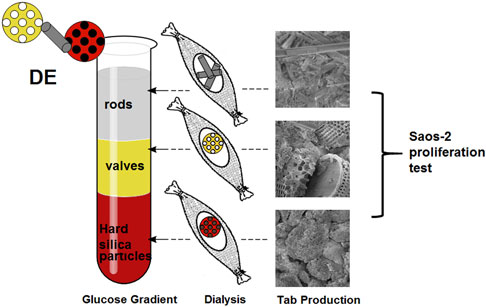Crossref Citations
This article has been cited by the following publications. This list is generated based on data provided by
Crossref.
Ragni, Roberta
Scotognella, Francesco
Vona, Danilo
Moretti, Luca
Altamura, Emiliano
Ceccone, Giacomo
Mehn, Dora
Cicco, Stefania R.
Palumbo, Fabio
Lanzani, Guglielmo
and
Farinola, Gianluca M.
2018.
Hybrid Photonic Nanostructures by In Vivo Incorporation of an Organic Fluorophore into Diatom Algae.
Advanced Functional Materials,
Vol. 28,
Issue. 24,
Ragni, Roberta
Cicco, Stefania R.
Vona, Danilo
and
Farinola, Gianluca M.
2018.
Multiple Routes to Smart Nanostructured Materials from Diatom Microalgae: A Chemical Perspective.
Advanced Materials,
Vol. 30,
Issue. 19,
Presti, M. Lo
Ragni, R.
Vona, D.
Leone, G.
Cicco, S.
and
Farinola, G. M.
2018.
In vivo doped biosilica from living Thalassiosira weissflogii diatoms with a triethoxysilyl functionalized red emitting fluorophore.
MRS Advances,
Vol. 3,
Issue. 27,
p.
1509.
Vona, Danilo
Mezzina, Nicoletta
Cicco, Stefania Roberta
Leone, Gabriella
Ragni, Roberta
Lo Presti, Marco
Farinola, Gianluca M.
Parak, Wolfgang J.
and
Osiński, Marek
2019.
Diatomaceous earth/polydopamine hybrid microstructures as enzymes support for biological applications.
p.
13.
Leone, Gabriella
Vona, Danilo
De Giglio, Elvira
Bonifacio, Maria Addolorata
Cometa, Stefania
Fiore, Saverio
Palumbo, Fabio
Ragni, Roberta
Farinola, Gianluca M.
and
Cicco, Stefania R.
2019.
Data from in vivo functionalization of diatom mesoporous biosilica with bisphosphonates.
Data in Brief,
Vol. 24,
Issue. ,
p.
103831.
Cicco, Stefania R.
Vona, Danilo
Leone, Gabriella
De Giglio, Elvira
Bonifacio, Maria A.
Cometa, Stefania
Fiore, Saverio
Palumbo, Fabio
Ragni, Roberta
and
Farinola, Gianluca M.
2019.
In vivo functionalization of diatom biosilica with sodium alendronate as osteoactive material.
Materials Science and Engineering: C,
Vol. 104,
Issue. ,
p.
109897.
Presti, Marco Lo
Vona, Danilo
Leone, Gabriella
Rizzo, Giorgio
Ragni, Roberta
Cicco, Stefania R.
Milano, Francesco
Palumbo, Fabio
Trotta, Massimo
and
Farinola, Gianluca M.
2019.
Nanostructured interfaces between photosynthetic bacterial Reaction Center and Silicon electrodes.
MRS Advances,
Vol. 4,
Issue. 31-32,
p.
1741.
Amoda, Adeleke
Borkiewicz, Lidia
Rivero-Müller, Adolfo
and
Alam, Parvez
2020.
Sintered nanoporous biosilica diatom frustules as high efficiency cell-growth and bone-mineralisation platforms.
Materials Today Communications,
Vol. 24,
Issue. ,
p.
100923.
Leone, G.
Ragni, R.
Vona, D.
Cicco, S. R.
Babudri, F.
and
Farinola, G. M.
2020.
A phosphorescent iridium complex as a probe for diatom cells’ viability.
MRS Advances,
Vol. 5,
Issue. 18-19,
p.
935.
Singh, Ramesh
Khan, Mohd Jahir
Rane, Jagdish
Gajbhiye, Ashmita
Vinayak, Vandana
and
Joshi, Khashti Ballabh
2020.
Biofabrication of Diatom Surface by Tyrosine‐Metal Complexes:Smart Microcontainers to Inhibit Bacterial Growth.
ChemistrySelect,
Vol. 5,
Issue. 10,
p.
3091.
Vicente-Garcia, Cesar
Losacco, Valentina
Vona, Danilo
Cicco, Stefania R.
Altamura, Emiliano
Farinola, Gianluca Maria
and
Ragni, Roberta
2021.
Straightforward and effective removal of phenolic compounds from water by Polydopamine coated Diatomaceous Earth.
p.
27.
Colaprico, Erica
Cicco, Stefania R.
Vona, Danilo
Rizzo, Giorgio
Ricciardelli, Carola
and
Farinola, Gianluca Maria
2022.
Efficient removal of a model textile dye from sea water by Polydopamine coated Diatomaceous Earth.
p.
106.
Flemma, Annarita
Vicente-Garcia, Cesar
Rizzo, Giorgio
Cotugno, Piero
Cicco, Stefania R.
Falciator, Angela
Farinola, Gianluca Maria
Vona, Danilo
and
Ragni, Roberta
2022.
Chemically decorated microalgae for environmental application.
p.
101.
Schröder, Heinz C.
Wang, Xiaohong
Neufurth, Meik
Wang, Shunfeng
Tan, Rongwei
and
Müller, Werner E. G.
2022.
Inorganic Polymeric Materials for Injured Tissue Repair: Biocatalytic Formation and Exploitation.
Biomedicines,
Vol. 10,
Issue. 3,
p.
658.
Cicco, Stefania Roberta
Giangregorio, Maria Michela
Rocchetti, Maria Teresa
di Bari, Ighli
Mastropaolo, Claudio
Labarile, Rossella
Ragni, Roberta
Gesualdo, Loreto
Farinola, Gianluca Maria
and
Vona, Danilo
2022.
Improving the In Vitro Removal of Indoxyl Sulfate and p-Cresyl Sulfate by Coating Diatomaceous Earth (DE) and Poly-vinyl-pyrrolidone-co-styrene (PVP-co-S) with Polydopamine.
Toxins,
Vol. 14,
Issue. 12,
p.
864.
Vona, Danilo
Flemma, Annarita
Piccapane, Francesca
Cotugno, Pietro
Cicco, Stefania Roberta
Armenise, Vincenza
Vicente-Garcia, Cesar
Giangregorio, Maria Michela
Procino, Giuseppe
and
Ragni, Roberta
2023.
Drug Delivery through Epidermal Tissue Cells by Functionalized Biosilica from Diatom Microalgae.
Marine Drugs,
Vol. 21,
Issue. 8,
p.
438.
Vona, Danilo
Cicco, Stefania Roberta
Labarile, Rossella
Flemma, Annarita
Garcia, Cesar Vicente
Giangregorio, Maria Michela
Cotugno, Pietro
and
Ragni, Roberta
2023.
Boronic Acid Moieties Stabilize Adhesion of Microalgal Biofilms on Glassy Substrates: A Chemical Tool for Environmental Applications.
ChemBioChem,
Vol. 24,
Issue. 13,
Sun, Xiaojie
Zhang, Mengxue
Liu, Jinfeng
Hui, Guangyan
Chen, Xiguang
and
Feng, Chao
2024.
The Art of Exploring Diatom Biosilica Biomaterials: From Biofabrication Perspective.
Advanced Science,
Vol. 11,
Issue. 6,






